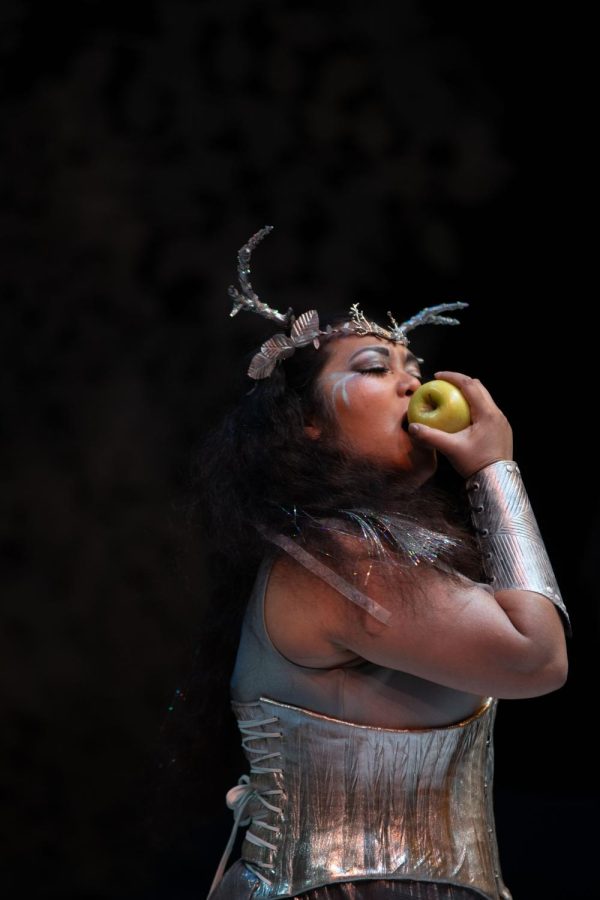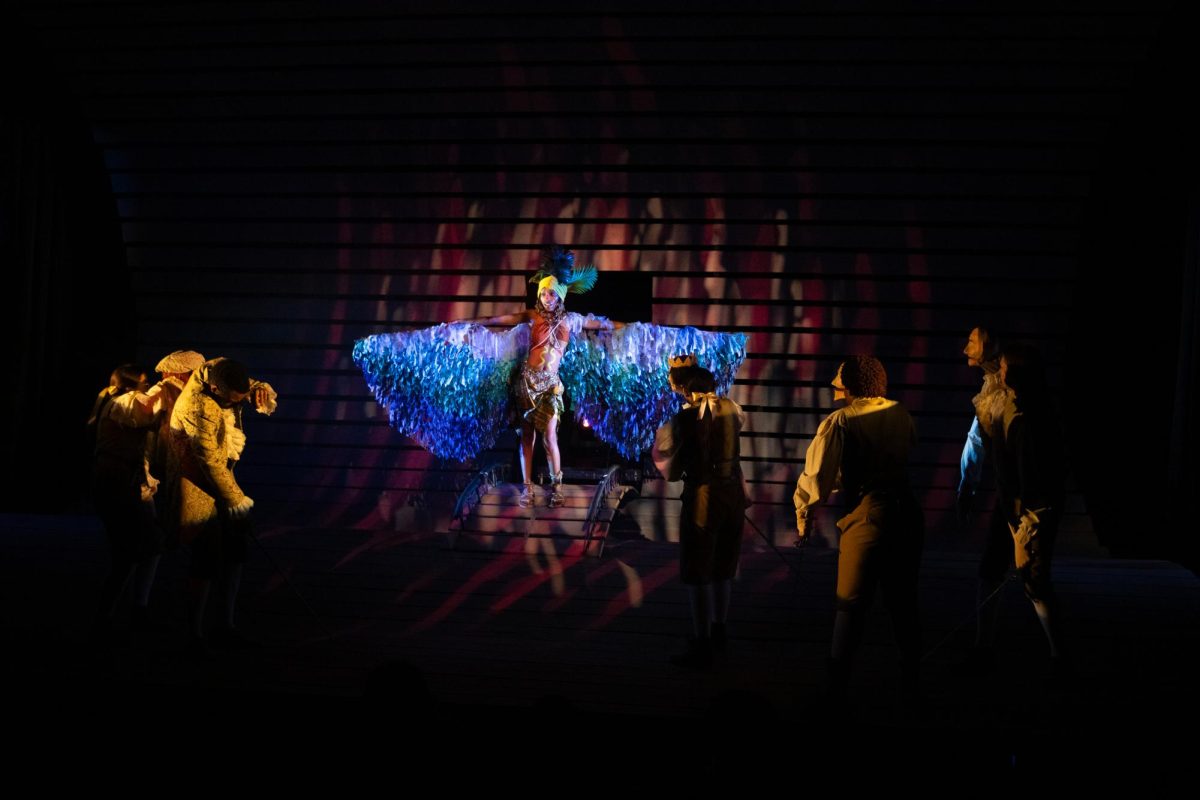Behind the Scenes: The Costume Design of “Artemis, I”
Anna Sosa is Artemis in “Artemis, I.” Artemis bites an apple as her goddesses recount the events leading up to the Trojan War.
March 20, 2023
“Artemis, I,” produced by the ODU Theatre in the spring of 2023, was a contemporary take on the story of Iphigenia, and nowhere was this more evident than the costume designs. The costume designer, Meredith Magoun, and several cast members talked about the wardrobe of the show, from the design inspirations to what the costumes mean for the characters.
“For ‘Artemis, I’, the idea for the costumes is modern Greek— I jokingly call it bougie Mediterranean,” said Magoun.
Magoun described the play as “Grecian, modern, and luxurious,” citing those adjectives as the starting point for her design. She conceptualized her ideas by finding images that evoked the same feelings as “Artemis, I”. Despite the modernity of the show, Ancient Greek statues were a heavy influence on her designs.
This inspiration was demonstrated in a literal sense with the goddesses of war. In the story of “Artemis, I”, the Greek chorus was represented by a pantheon of ten Greek war goddesses. They were posed around the set as statues that came to life to help Artemis enact her revenge. The effect was achieved by using makeup and body paint to transform the actors into sculptures of silver. The effect was completed with silver wigs styled in unique braided hairstyles adorned with painted leaves.
The intense silver of the goddesses connected them to their leader, Artemis. She was more modern in her design, sporting a silver dress with a corset and silver-painted combat boots. She wore a headband with antlers to call back to her sacred deer and denote her as the goddess of the hunt.
Anna Sosa, who played Artemis, felt that her costume needed to exude power.
“I actually feel quite powerful in a corset. It makes me feel not like I’m in a cage, but like I’m about to burst out of one,” she said.
On the other side of divinity, Apollo had a metallic gold motif. His costume was layered with several shades of gold, but the most prominent were the golden pauldron he wears on one shoulder and the glittering gold high-tops that rooted him in the contemporary tone. While Artemis looked battle-ready, Apollo looked the part of a casual observer who only interfered based on his own whims.
While the show took inspiration from the past, the look of the mortal characters was modern and Mediterranean-inspired. Angelina Paquin, who played Iphigenia, compared the look to a party attending a destination wedding. The mortal characters in the play, including Agamemnon, his family, and the soldiers, all wore white to pay homage to the marble sculptures of Ancient Greek figures. Artemis and Apollo even donned white cloaks to blend in during scenes where they pretended to be mortals.
“[Wearing white] symbolizes that we’re all a part of one, that shows that it’s a side of the war,” said Adrian Rivera, who played Achilles.
The Pythia was a mortal character with a tether to the divine. The Pythia entered the stage wearing a simple linen dress with a hood, but during one scene, a black light came on, revealing patterns on her dress painted in black light paint. Thanks to special makeup, the black light also revealed glowing veins on the Pythia’s neck and arms. In the scene, the Pythia screamed that Apollo had taken her eyes, an effect achieved with her eyeshadow glowing in the blacklight. The Pythia may have started off as mortal, but her connection to Apollo changed her.
Despite the unnerving connection it symbolizes, Reicse Owen, who played the Pythia, spoke highly of the garment. The breathable linen material kept her comfortable throughout the show.
“This is probably my favorite costume I’ve ever had, even though it’s the simplest costume I’ve ever had,” said Owen.
According to Magoun, the Pythia’s costume needed a magical element, which became a question of how to make magic on stage. Lighting designer Woody Robinson set up the black light that brought the stage magic to the Pythia’s prophecy. The Pythia’s moment of prophecy would not have been what it was without collaboration with the costume and lighting designers.
The mortal soldiers wore simple garments in shades of white and cream. Menelaus and Odysseus wore linen shirts and long pants, looking rather casual for soldiers. Achilles, the greatest warrior in the Greek army, was given a white leather jacket and combat boots to separate him from the other soldiers. King Agamemnon had a pair of aviator shades hanging from his white jacket, giving him the desired silhouette of casual power.
It took Magoun a while to come up with the designs for the soldiers because she did not want to default to using camouflage.. She eventually settled on a design with dictatorship and cartel leader elements, since it would remind audiences of conglomerates of people fighting over small kingdoms, much like the Greeks did.
Iphigenia was the only character in the play with a complete costume change. In her first scene, she wore a simple dress with an apron as she was called from the kitchens. For the rest of the play, she wore a white dress with a sheer white overlay. Visually, it resembled a simpler version of her mother Clytemnestra’s costume.
“The costumes show how pure she is and how innocent she is as a kid, and how it highlights the tragedy that happens to her,” said Paquin.
Clytemnestra cut a queenly figure onstage. She wore a long white dress with a sheer cape that swept over her shoulders and trailed behind her on the floor. The lack of sleeves allowed her to easily handle the sword that she took from Odysseus, demonstrating that she is a proud warrior in addition to being a queen.
“Artemis, I” was a grand show thanks in part to the excellent design team behind it: costume designer Meredith Magoun, set designer Jim Lyden, lighting designer Woody Robinson, and director and sound designer Deborah Wallace. They collaborated with each other to create the immersive, magical world of the play.
“The best magic on stage is a collaboration between all of the departments,” said Magoun.









